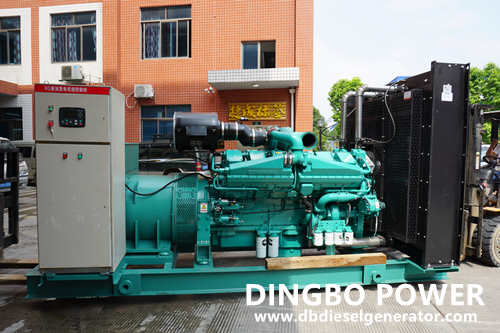dingbo@dieselgeneratortech.com
+86 134 8102 4441

- Home
- Products
- About Us
- Service
- News
- Technical Support
- Contact Us
dingbo@dieselgeneratortech.com
+86 134 8102 4441
Oct. 24, 2021
1.Cylinder head nut. When tightening the cylinder head nut, it should be tightened step by step to the specified torque in several times, and proceed according to the principle of first in the middle, then two sides, and diagonally crossing. When disassembling the cylinder, it should also be loosened gradually in the prescribed order. If the cylinder head nut is tightened unevenly or unbalanced, it will cause the cylinder head plane to warp and deform. If the nut is overtightened, the bolt will be stretched and deformed, and the body and threads will also be damaged. If the nut is not tightened enough, the cylinder will leak air, water, and oil, and the high temperature gas in the cylinder will burn the cylinder gasket.

2. Flywheel nut. For example, the flywheel and crankshaft of the S195 diesel engine are connected by a tapered surface and a flat key. When installing, the flywheel nut must be tightened and locked with a thrust washer. If the flywheel nut is not tightened tightly, a knocking sound will be produced when the diesel engine is working. In severe cases, it will damage the cone of the crankshaft, cut the keyway, twist the crankshaft, and cause serious accidents. Also note that the corners of the thrust washer can only be folded once.
3. Connecting rod bolts. The connecting rod bolts made of high-quality steel bear great impact during work, and cannot be replaced by ordinary bolts. When tightening, the torque should be uniform, and the two connecting rod bolts should be tightened gradually to the specified torque in several turns, and finally locked with galvanized iron wire. If the connecting rod bolt tightening torque is too large, the bolt will be stretched and deformed or even broken, causing a cylinder ramming accident; if the connecting rod bolt tightening torque is too small, the bearing gap will increase, knocking sound and impact load will occur during work, or even occur The accident of broken bushing and connecting rod bolts.
4. Main bearing bolts. The installation accuracy of the main bearing should be ensured without looseness. When tightening the main bearing bolts (for a fully supported four-cylinder crankshaft), the 5 main bearings should be in the order of the middle, then 2, 4, then 1, 5, and evenly tighten them to the specified level in 2 to 3 times. Moment. Check whether the crankshaft rotates normally after every tightening. The hazards caused by the excessive or small tightening torque of the main bearing bolts are basically the same as those caused by the excessive or small tightening torque of the connecting rod bolts.
5. Balance weight bolts. The balance weight bolts should be tightened to the specified torque in several steps in sequence. The balance weight should be installed in the original position, otherwise it will lose its balance function.
6. Rocker arm seat nut. For the rocker arm nut, it should be checked regularly and regularly combined with maintenance during use. If the rocker arm seat nut is loose, the valve clearance will increase, the valve opening will be delayed, the valve closing will be advanced, and the valve opening duration will be shortened, resulting in insufficient air supply of the diesel engine, poor exhaust, reduced power, and increased fuel consumption.
7. The fuel injection nozzle lock nut. When installing the fuel injector, its lock nut should be tightened to the specified torque. At the same time, re-tighten several times, not one time. If the lock nut of the fuel injector is tightened too tightly, the lock nut will be deformed and the needle valve will be easily blocked; if it is tightened too loosely, it will cause the fuel injector to leak, the fuel injection pressure will drop, and the atomization will be poor. Increased fuel consumption.
8. The oil outlet valve is tightly seated. When installing the fuel injection pump's delivery valve tightly seat, it must also be carried out according to the specified torque. If the oil outlet valve seat is over-tightened, the plunger sleeve will be deformed, the plunger will be blocked in the sleeve, and the plunger assembly will be worn out early, the sealing performance will decrease, and the power will be insufficient; If the tight seat is too loose, it will cause the fuel injection pump to leak oil, the oil pressure cannot be established, the fuel supply time lags, and the fuel supply is reduced, which seriously affects the engine performance.
9. Injector pressure plate nut. When installing the injector assembly on the cylinder head of the diesel engine of diesel generator, in addition to removing the dirt such as carbon deposits in the injector assembly mounting seat, the pressure plate of the injector assembly should not be installed reversely, and the thickness of the steel gasket should be appropriate and not missing. , Also pay attention to the tightening torque of the pressure plate nut of the injector assembly. If the tightening torque of the pressure plate nut is too large, the valve body of the injector will be deformed, causing the injector to jam, and the diesel engine will not work; if the tightening torque is too small, the injector will leak air, resulting in insufficient cylinder pressure and difficulty in starting the diesel engine. , The high temperature gas will also rush out and burn out the fuel injector.
In addition, when installing the sliding vane rotor of the distribution pump and the high-pressure oil pipe joints on the casing of the distribution pump, the required torque is also performed.
Quicklink
Mob.: +86 134 8102 4441
Tel.: +86 771 5805 269
Fax: +86 771 5805 259
E-mail: dingbo@dieselgeneratortech.com
WhatsApp: +86 134 8102 4441
Add.: No. 10 Kechuang Road, High tech Zone, Nanning, Guangxi, China